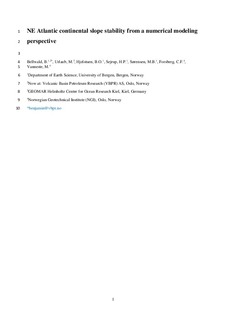NE Atlantic continental slope stability from a numerical modeling perspective
Bellwald, Benjamin; Urlaub, Morelia; Hjelstuen, Berit Oline Blihovde; Sejrup, Hans Petter; Sørensen, Mathilde B.; Forsberg, Carl Fredrik; Vanneste, Maarten
Peer reviewed, Journal article
Accepted version
Permanent lenke
http://hdl.handle.net/11250/2575826Utgivelsesdato
2018Metadata
Vis full innførselSamlinger
- NGI articles [1061]
Sammendrag
Trough mouth fans are environments characterized by high sediment supply during glacial stages and the occurrence of large-scale instabilities. The geological record indicates that several of these environments have failed repeatedly resulting in large submarine landslides. The roles of sedimentation rate, weak layers, glacial loading and unloading as well as seismic activity on triggering megaslides in trough-mouth-fan systems is still unclear. A better understanding of the preconditioning factors, triggers and consequences of these landslides is crucial due to the hazard they pose to coastal communities and offshore industries. In this paper, we focus on the North Sea Trough Mouth Fan, which is the result of massive glacial sediment input delivered to the shelf edge through the Norwegian Channel, southeast Nordic Seas margin. The Tampen Slide, one of several large paleo-landslides that have happened within the North Sea Trough Mouth Fan, took place at c. 130 ka (end of MIS 6), and removed an estimated 1800 km3 of sediment. Here, we use boundary conditions from the Tampen Slide and 2D Finite Element Modeling (Abaqus software from Simulia) to evaluate the effects of variations in sedimentation rates as well as sediment properties on the generation of excess pore pressure, fluid flow, and slope stability along the axis of the trough-mouth-fan system. The model domain, 40 km in length and 2 km in height, is dominated by glacigenic debris flows and glacimarine sediment deposits. We use geotechnical data measured on samples of glacigenic and glacimarine sediment deposits from the nearby Ormen Lange gas field area to constrain the model. We evaluate the stability of the slope under various scenarios, including constant sediment loading, episodic changes in sedimentation rates and abrupt pulses in sediment delivery for a 61 kyr period (MIS 6). The models show that increased sedimentation rates during glacial stages do not generate sufficient excess pore pressure to set off a landslide. Furthermore, the simulated overpressures for the different sedimentation scenarios do not significantly differ at the end of the model runs. The results also highlight the importance of a basal glacimarine sediment layer underneath the rapidly-deposited sediments for the build-up of overpressure. Consequently, this glacimarine sediment layer has the inherited potential to act as a weak layer facilitating instability. However, as overpressure due to sediment deposition alone does not result in slope failure, we couple the preconditioned slope with earthquake ground shaking. Based on attenuation models, an earthquake of approximately M6.9 or larger at a short distance from the Tampen Slide headwall could have triggered the landslide. Therefore, we suggest glacial sedimentation and a glacimarine sediment layer to represent preconditioning factors, and seismic shaking as the final trigger mechanism for the Tampen Slide, i.e. similar to the situation that lead to the development of the Storegga Slide in the same area. NE Atlantic continental slope stability from a numerical modeling perspective
